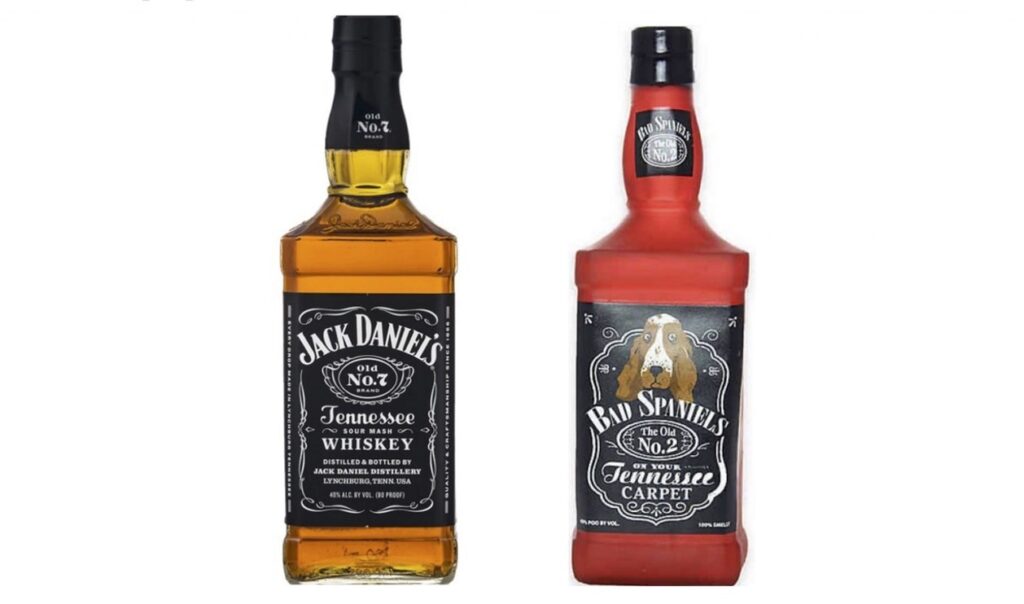
Supreme Court’s Bad Spaniels Decision Limits Parody Defense to Trademark Infringement
By Sabrina Larson and Christopher Wiener
On June 8, 2023, the Supreme Court issued a unanimous decision in Jack Daniel’s Properties, Inc. v. VIP Products, limiting the scope of a parody defense to a trademark infringement claim.
The Takeaways
- The test for likelihood of confusion must be applied where an infringer uses a trademark as a trademark to identify the source of its goods, even if it claims that use is a parody, rather than the First Amendment analysis applicable to the use of marks in expressive or artistic works.
- The use of a mark as a parody does not shield an infringer from a dilution claim (alleged based on famous marks) where it uses the trademark as a trademark, to identify the source of its goods.
Background
VIP makes and sells a line of dog toys called “Silly Squeakers” designed to look like and to parody popular beverage brands, including toys named Dos Perros, Smella Arpaw, and Doggie Walker, to name a few. At issue here is VIP’s “Bad Spaniels” toy, designed to evoke the distinctive Jack Daniel’s brand and bottle:
In addition to the overall trade dress of the bottle and label, the Bad Spaniels toy mimics numerous specific elements of the Jack Daniel’s bottle, many of which are registered trademarks. For example:
- “Bad Spaniels” instead of “Jack Daniel’s”
- “The Old No. 2 On Your Tennessee Carpet” instead of “Old No. 7 Tennessee Sour Mash Whiskey”
- “43% poo by vol.” and “100% smelly” instead of “40% alc. by vol. (80 proof ).”
As the Supreme Court wryly summarized, the “jokes did not impress” Jack Daniel’s. It claimed both trademark infringement and dilution.
Use of Someone Else’s Trademark in Expressive Works: The Rogers Test
VIP defended its use of the Jack Daniel’s trademarks under the First Amendment—claiming that the Bad Spaniels toy is an “expressive work.” It claimed that the Rogers test applied to its use of the trademarks and that as protected speech, the typical analysis for trademark infringement, whether the use of the trademark creates a likelihood of confusion as to the source of the goods, did not apply to the Bad Spaniels toy.
The Rogers test dates to a 1989 case from the Second Circuit, Rogers v. Grimaldi, 875 F.2d 994 (2d Cir. 1989), and has since been applied by courts in many circuits to analyze use of trademarks in “expressive works,” where trademark rights and free speech rights under the First Amendment intersect. Rogers addressed potential infringement in the context of titles of expressive works—Ginger Rogers claimed Fellini’s film title incorporating her name was an infringement. The court disagreed, reasoning that the “expressive element of titles requires more protection than the labeling of ordinary commercial products.”
Although Rogers dealt with titles of creative works, the test has since been applied broadly to the use of trademarks within an artistic or expressive work. When it is applied, Rogers requires dismissal of infringement claims where the trademark is used in an expressive work—without turning to a likelihood of confusion analysis—unless (i) the use of the mark has no artistic relevance to the underlying work or (ii) the use of the mark explicitly misleads as to the source or content of the work. The lead-up to the Bad Spaniels decision involved extensive debate over whether the Rogers test should be stricken or modified.
Jack Daniel’s Trademark Infringement Claim
The Supreme Court did not overrule the Rogers test, but it clarified that the test does not apply when the alleged infringer uses the trademark as a trademark—i.e., as a source-identifier for its own goods. Rogers remains a “cabined doctrine” applying only when the defendant uses the mark in a non-source identifying way. Here, the Court concluded, VIP was using the Bad Spaniels trademarks as trademarks, to identify the source of the VIP dog toy products, a point that VIP had earlier conceded in the case. Accordingly, the only question that remains is whether the Bad Spaniels trademarks are likely to cause confusion with the Jack Daniel’s trademarks as to the source of each party’s products.
The Supreme Court remanded the case to determine the question of likelihood of confusion. The issue of parody was, however, not resolved. While it cannot be analyzed under the Rogers test, VIP’s claimed use of the marks as parody will be relevant to likelihood of confusion. A successful parody must conjure up the original work while also creating a contrast, to make the message of ridicule or humor clear. If parody is done successfully, it is typically not likely to create confusion.
Jack Daniel’s Dilution by Tarnishment Claim
Jack Daniel’s also claimed that the Bad Spaniels toy constituted dilution by tarnishment of its famous trademarks. Dilution applies where the asserted trademark is famous—widely recognized by the public as designating the source of goods. 15 U.S.C. § 1125(c). Dilution can occur where an infringer uses a famous trademark for unrelated goods, creating an association that harms the reputation of the famous trademark: that is, for Jack Daniel’s, the association of its whiskey with dog excrement.
A statutory exception to dilution is where the use of the trademark is “noncommercial.” VIP argued that its Bad Spaniels toy, despite being sold to consumers, was a noncommercial use because it parodied Jack Daniel’s. The Court held, however, that the use of a trademark is not necessarily noncommercial simply because it parodies another’s product. Instead, it again matters whether the trademark is being used as a trademark, to designate the source of goods.
The Takeaways Revisited
The Bad Spaniels decision narrows defenses that rely on the parodic nature of the use of the trademark. Instead, even if the intended use is a parody, the traditional trademark infringement analysis of likelihood of confusion will apply if the trademark is used to designate the source of the goods. Likewise, the noncommercial exception to a dilution claim cannot be invoked simply because the use is an intended parody. Parody is and remains, however, relevant to the likelihood of confusion analysis. Those who engage in parodies should carefully consider whether the parody is being used as a source identifier of their own goods or services—and if it is, to carefully consider whether it is likely to cause confusion. Meanwhile, the Rogers test remains intact, applying, as it traditionally has, in instances where the parody is not being used as a trademark.
To view a PDF version of this article, please click here.
